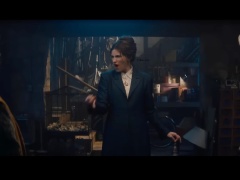
SPOILER alert: This post contains spoilers from the two-episode premiere of “Expats,” now streaming on Prime Video.
Lulu Wang can’t escape Blondie’s “Heart of Glass.”
At first, the acclaimed writer-director of “The Farewell” thought she was just hyper aware of the 1978 classic after she’d handpicked it to score the single moment of genuine happiness in the premiere episode of “Expats,” her new Prime Video limited series. The scene in question finds series stars Nicole Kidman and Sarayu Blue letting loose and dancing to the song during a late-night meal in a Hong Kong restaurant.
But in recent weeks, Wang says the song has followed her beyond the world of the series, which follows wealthy American expats living in Hong Kong, and the locals with whom their lives intersect. Wang first noticed its omnipresence when she walked into the gym and it was playing. She laughed it off as a funny coincidence, until a few days later when she heard it at a dinner party the moment she stepped through the door. It happened again while out to dinner with her partner, director Barry Jenkins, as “Heart of Glass” started to play and someone cranked it up to a deafening volume in the restaurant.
“It has kind of haunted me,” Wang tells PvNew, as Kidman sits next to her and starts to sing a few bars from the chorus. “I think it’s a good sign though.”
Kidman stops her rendition just in time to add, “It really is a classic!”

In the premiere, the song serves as a euphoric interruption in an otherwise tough evening out for Kidman’s character Margaret, a landscape architect who has a very public incidentduring a 50th birthday party for her husband, Clarke (Brian Tee). Throughout the episode, Margaret is a raw nerve walking through life, entirely under the influence of grief after her youngest son, Gus, has gone missing. Already overstimulated by the festivities and her oppressive in-laws, Margaret devolves into a panic when she sees Mercy (Ji-young Yoo), the young woman who was responsible for Gus when he disappeared, among the catering staff. Looking to confront an elusive Mercy, Margaret mistakenly accosts an innocent server in front of a judgmental audience of onlookers before fleeing the party with her friend and neighbor Hilary (Blue). The two expats find themselves the lone customers in a diner musing about escaping the realities of their lives when they get swept away by the Blondie tune and dance like no one is watching –– except the confused kitchen staff.
“In Hong Kong, there is a lot of pop music and music from the ‘80s that plays,” Wang says. “It is one of my favorite songs, and it was just a moment of levity that I felt like we really needed at that point in the episode. There’s something really haunting about the joy of that song juxtaposed with Margaret snapping out of the moment. There’s a guilt to feeling happiness when there is trauma, when you don’t know where your child is. And I thought that song made it a beautiful moment for the both of them.”
Kidman, whose production company Blossom Films optioned Janice Y.K. Lee’s novel “The Expatriates” and brought on Wang to direct and write the adaptation, says she needed that scene and that song as much as Margaret.
“It was nice to be able to laugh and dance,” she says. “We were all dancing at one point, and I think we needed it.”
Playing Margaret was no easy lift for Kidman, despite an extensive pedigree of series like “Big Little Lies” and “The Undoing” in which motherhood has been the beating heart of the story.
“I think it was the idea of having to play a woman whose child is missing, that is what was so challenging,” Kidman says. “We see very little of the time when I’m with Gus, most of the series takes place when he is gone and the idea of that embedding into me, physically and emotionally, was probably the toughest part over the course of a six-hour story.”
The series premiered with both its first and second episodes, which serve as non-linear complements to one another. The first episode opens in 2014, a year after Gus goes missing, with Margaret’s family still struggling to find some solace in a sea of unanswered questions. The party debacle serves as another crashing wave in that battle.
The second episode then flashes back to the events leading up to the disappearance, with Margaret meeting Mercy by chance, and courting her to help care for Gus and his older siblings. The creeping dread of what the audience knows awaits this otherwise happy family looms over the episode’s final act when Margaret, Mercy and the kids visit one of Hong Kong’s eclectic street markets. It is there that Gus simply disappears into the densely packed crowd while on Mercy’s watch, shattering more than a few lives.
The nonlinear storytelling, which continues through the remaining four episodes, was part of Wang’s unwavering vision for the material, according to Kidman.
“When we were first developing it, we were stuck with the timeline,” Kidman says. “But Lulu came in and went, ‘Oh no, this is how it’s going to be,’ and structurally, really cracked it open. It changed everything immediately. And as a performer, I was given this wonderful complexity that I could explore under the guidance of Lulu.”
Although the first two episodes chart the making and aftermath of a tragic mystery for Margaret’s family, Wang never saw the series as something to be solved — but rather a humanity to be found.
“I was interested in something I could make nonlinear, and something that wasn’t about a whodunit,” she says. “It isn’t about the plot of just figuring it out and solving some mystery. There is a lot of that mystery and intrigue and mystic and atmosphere. But I think what ultimately drew me to doing it was the chance to play with not only different timelines but different perspectives within the world of Hong Kong.”
Those points of view, while living parallel to each other, may never intersect.
“That’s how life is, though,” Wang says. “We all exist right next to each other, and there’s one or two degrees of separation — and we never meet.”
That is never more true than in the missed connections of the street market where Gus goes missing, and where the first and second episodes both end. For Episode 2, Wang shot an on-location time lapse of the real market breathing life back into itself every morning, and putting itself to sleep every night. The crowded-to-cavernous life cycle is a captivating trance the show sits with immediately following the realization that Gus is gone.
Seeing the void of the market at night calls back to the end of the first episode, when a dazed Margaret, having just let light and Blondie back into her life at the diner, goes back to the scene of the disappearance, and walks through its shuttered strait of vendors. The image of Kidman, with slacked posture and aimless direction, is the key promotional image for the series — and a scene that Kidman and Wang agree the first two episodes would be incomplete without.
“By that stage, I was so in the character,” Kidman says. “We shot so much in that market. Some of it is in the show, and some of it isn’t. It was a rollercoaster. But it very much needed to be the market that bookends those two episodes. That is just what it had to be.”






